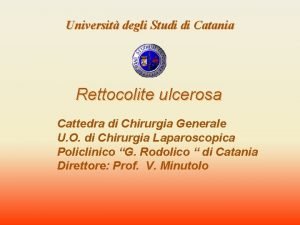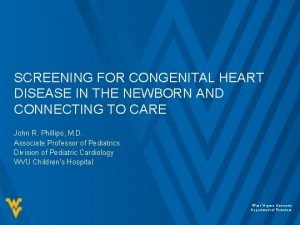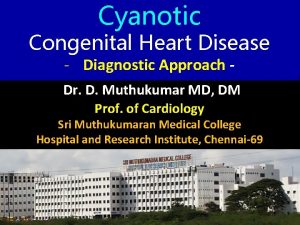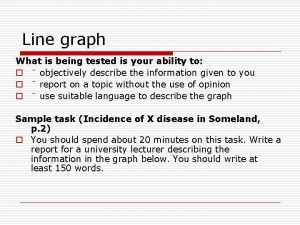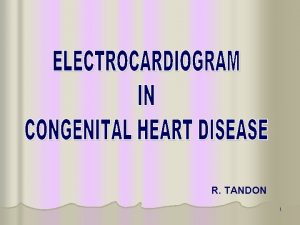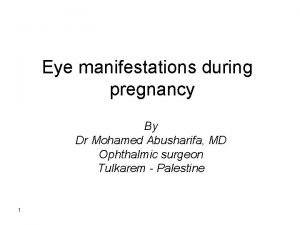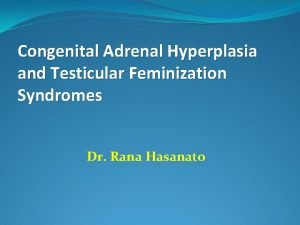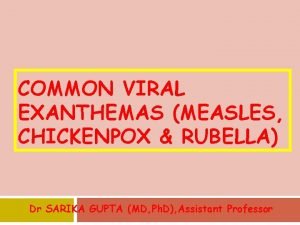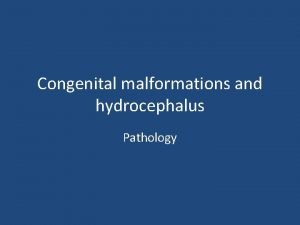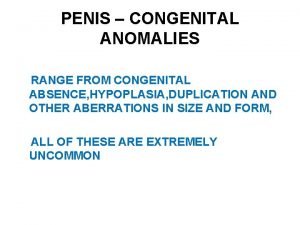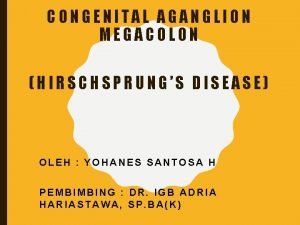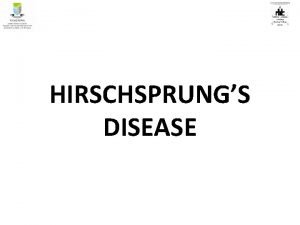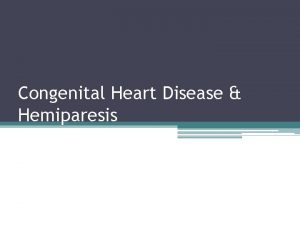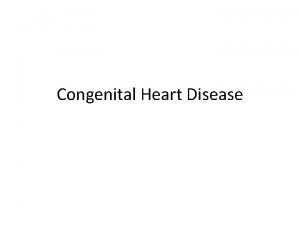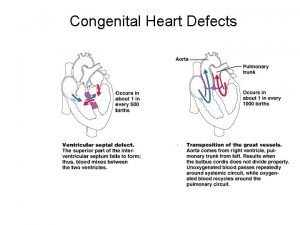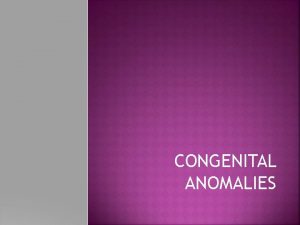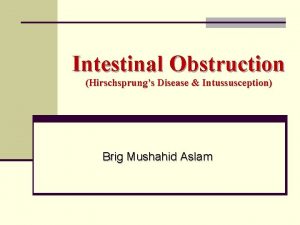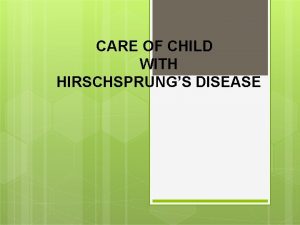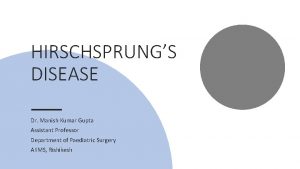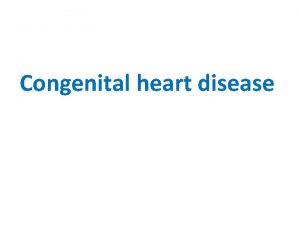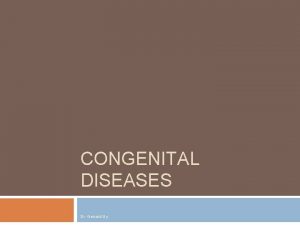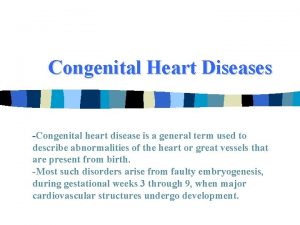Congenital Megacolon Hirschsprungs disease R 3 Incidence n

















- Slides: 17

Congenital Megacolon (Hirschsprung’s disease) 소아과 R 3 안선영

Incidence n absence of ganglion cells in the bowel wall beginning in the internal anal sphincter and extending proximally n 1/5000 live births n M: F = 4: 1 n Racial distribution similar

Embryology and Etiology n Neuroenteric cells migrate from neural crest to upper end of alimentary tract and proceed in distal direction n 12 th week : migration to distal colon – first into myenteric (Auerbach’s plexus) then into submucosal plexus n Embryologic defect

n Failure of neural crest migration n Immunologic mechanism: increased expression of class II antigens in the mucosa and submucosa-> causes fetus to mount an immunologic response against the neuroblast n Genetic factors: May affect more than one family member in 3 -7% of cases n Deletion in the RET gene chromosome 10 q 11 and EDNRB gene located on 13 q 22 and EDN 3 gene (major role in the development of the enteric nervous system)

Pathology n Neonatal period: intestine is normal n Proximal ganglionic intestine hypertrophies and becomes thicker and longer than normal n Taeniae disappear and longitudinal muscle layer completely surrounds colon n Distal intestine: absence of ganglion cells in the submucosal (Meissner’s) plexus and myenteric (Auerbach’s) plexus n Marked increase in nerve fibers which extend into the submucosa (seen with acetylcholinesterase stain) n Aganglionosis extends to rectosigmoid region in 80% of cases

Clinical Symptoms n Should be considered in any child who has history of constipation dating to newborn period n 90% of cases diagnosed in newborn period n Most common presentation in newborns: delayed stool passage within first 48 hrs of life n Constipation, abdominal distension, poor feeding and vomiting n Constipation followed by explosive diarrhea, failure to thrive n in older children, large fecal mass palpable in left lower quadrant. rectum is empty n stools: small pellets, ribbon-like, fluid consistency

n Rectal exam: normal anal tone followed by explosive discharge of feces and gas n failure to pass stool leads to dilatation of proximal bowel -> increased intraluminal pressure, decreased blood flow and deterioration of the mucosal barrier n stasis leads to bacterial proliferation and enterocolitis with sepsis n early diagnosis important in reducing mortality

n Study of 123 patients with HD n 60% were diagnosed in neonatal period n Delayed passage of meconium (65%), abdominal distension and constipation n 17% had associated anomalies n 86% had aganglionosis extending to rectosigmoid region

Associated Anomalies n Present in 10 -30% of HD n Urogenital tract (11%), cardiovascular system (6%), GI system (6%), other malformations, cataract, cleft palate (8%) n 3% Down SD

Diagnosis I n Abdominal x-rays: air fluid levels in colon and distended loops of intestine n Barium enema: narrow distal segment and dilated proximal intestine; presence of funnel-shaped transition zone between these 2 segments (diagnostic accuracy 80 -90%) n Transition zone may not be present before 1 -2 weeks of age n significant barium remaining in colon in 24 -hr delayed film n helpful in determining level of aganglionosis n Should not be done with clinical enterocolitis: may cause perforation

Diagnosis II n Anorectal manometry: absence of relaxation reflex after distension of balloon in rectum n Diagnostic accuracy 85% n May be done at bedside or as outpatient procedure : no complications n Test unreliable in cases where gestational age plus age after birth is less than 39 weeks and weight is less than 2. 7 kg

Diagnosis III n Rectal biopsy: gold standard n Can be performed at bedside without general anesthesia n Biopsy taken at 2 cm, 3 cm, 5 cm above dentate line n Diagnostic accuracy: 99. 7% n Most common problem is inadequate specimen (insufficient amount of submucosa)

Differential diagnosis n Meconium plug SD, small left colon SD, distal ileal atresia, low imperforate anus n Neonatal sepsis, hypothyroidism, brain injury, prematurity may result in delayed passage of stool

Treatment n Decompression: nasogastric tube, rectal tubes n perform surgery after diagnosis established or perform temporary colostomy until infant is 6 -12 mos old n 3 basic surgical approaches:

1) Swenson: excise aganglionic segment and anastomose the normal proximal bowel to the rectum 1 -2 cm above the dentate line 2) Duhamel: neorectum created-> normally innervated bowel brought down behind aganglionic rectum: anterior aganglionic half with normal sensation and posterior half ganglionic with normal propulsion

3) Soave: endorectal pull- through procedure-> strip mucosa from the aganglionic rectum and bring normally innervated colon through the residual muscular cuff Ultrashort segmental HD: excision of strip of rectal muscle

Complications n Early complications: anastomotic strictures (15%), wound infections (11%), anastomotic leaks (7%) n Late complications: chronic constipation, enterocolitis, encoporesis n Good prognosis: more than 90% of children achieve normal bowel movement
 Incidence vs incidence rate
Incidence vs incidence rate Epirates
Epirates Megacolon tossico rx
Megacolon tossico rx Copyright ppt
Copyright ppt Farah garmany
Farah garmany Difference between cyanotic and acyanotic heart disease
Difference between cyanotic and acyanotic heart disease Cyanotic vs acyanotic
Cyanotic vs acyanotic Juxtaductal position
Juxtaductal position Incidence of x disease in someland
Incidence of x disease in someland Communicable disease and non communicable disease
Communicable disease and non communicable disease Puberty disorder
Puberty disorder Congenital heart
Congenital heart Congenital toxoplasmosis
Congenital toxoplasmosis Feminization tubes
Feminization tubes Rds pathophysiology
Rds pathophysiology Congenital rubella syndrome triad
Congenital rubella syndrome triad Congenital malformations
Congenital malformations Erythroplasia of queyrat
Erythroplasia of queyrat


